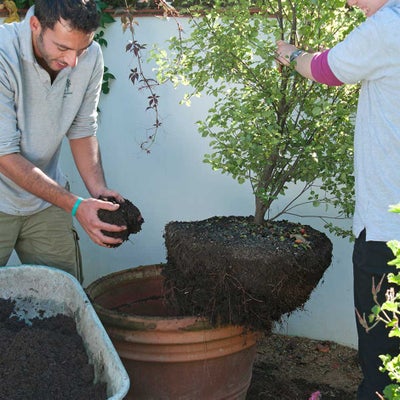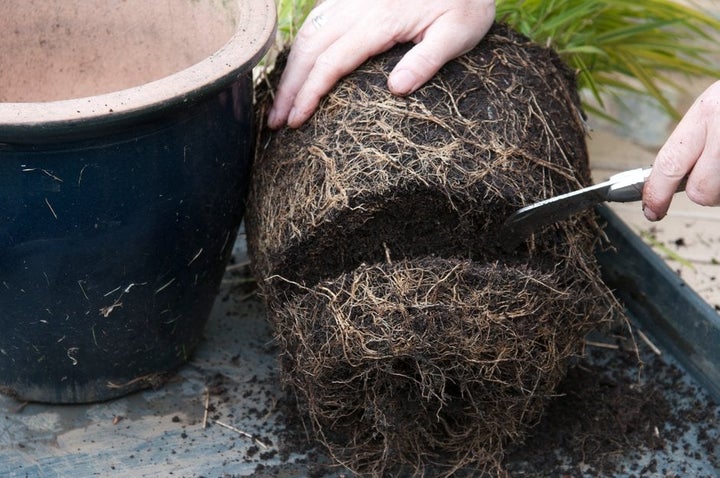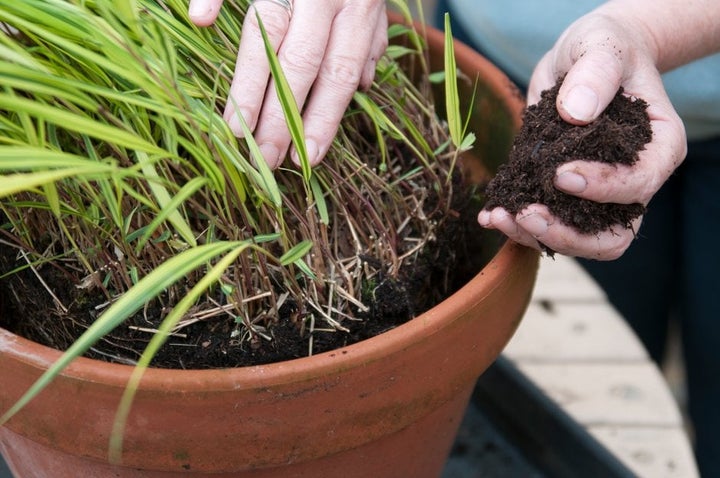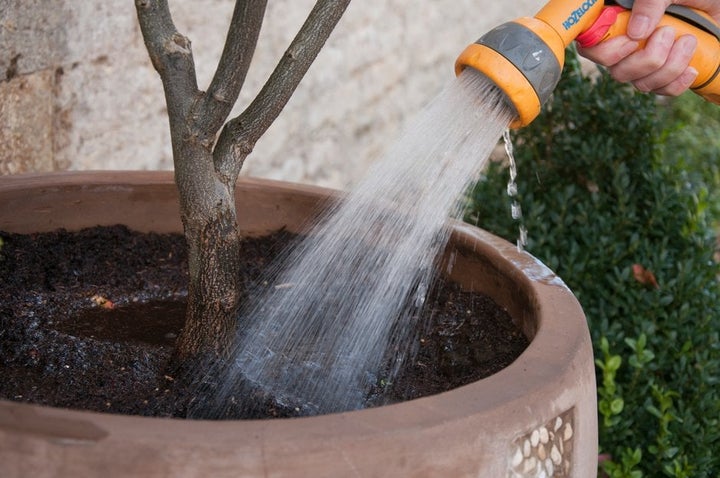
Quick facts
Lifting a plant out of its container is the best way to see if its roots are congested.
A mass of roots spiralling around the bottom of a container, or growing out through the holes, can prevent water draining properly and lead to root rot.
How vigorous your plant is, the type of compost it is in, and the container size, determine how often you need to repot.
Spring, as plants start into growth, is generally the best time to repot and prune roots.
Getting started
Why
The roots of container plants only have a limited space in which to grow, and a limited amount of to absorb water and from. Plant growth slows if roots don’t have sufficient space. The amount of top growth a plant makes will be limited by a restricted root system; with space, plus the age and quality of the compost, determining the rate of growth. Compost slumps over time as the organic materials in it break down, reducing air spaces, drainage, and nutrient and water retention – all of which limit normal healthy growth. A congested mass of roots can also prevent water draining properly, leading to saturated compost and the risk of root rot.
Repotting aims to give roots more growing space and a richer, better drained and better environment to grow in. Pruning the roots and shoots of plants grown in containers will limit the size of your plant, as is the case with bonsai, but your plant will still need to produce some new growth to remain healthy and perform well.
When
Repotting once every three to five years is suitable for most plants. Spring is a good time to repot most trees, shrubs and grasses, as they are beginning to put on growth and will benefit from the increased space. Early to midsummer is also suitable for repotting many plants. It is best to avoid repotting in autumn or winter when plant growth slows or completely stops, as this increases the risk of fresh compost sitting too wet.
Herbaceous perennials can be divided at the same time as repotting, allowing divisions to be replanted back into the same container, improving vigour and performance. Many summer-flowering are best divided in spring. Spring-flowering perennials often benefit from division in summer. See our guide to dividing perennials for more information.
When repotting into a larger container, the new pot should be no more than one third larger than the current one. For containers less than 25cm (10in) in diameter and depth, aim to repot into a container about 2.5-5cm (1-2in) deeper and wider than the previous one. Any bigger and you might encounter issues with overpotting – see our guide to overpotting for more information.
Root pruning
The expense of buying larger containers, plus their size and weight, can make potting into a larger container unfeasible. Many plants can remain healthy for years when grown in the same sized container if the roots are pruned. A light trim, removing up to 15% of the root system, every few years can be sufficient. However, if roots have become very congested, you can cut a slice off one side or the base of the . Staggering the reduction of a rootball over a few years limits the amount of stress to the plant. For plants suited to spring or early summer pruning, including many early-flowering and late-flowering shrubs, reducing the top growth at the same time as root pruning keeps the root to shoot ratio in balance.
Refreshing compost
If root pruning isn’t necessary or suitable for your plant, you can simply refresh some of the compost. Organic materials in compost break down over time, and after a few years you’ll notice the compost level in your pot drop. Lifting a plant out and adding a layer of fresh compost to the bottom of the container is a quick and simple way to improve conditions for root growth. An even better option is to remove old, loose compost from the sides and the top of the rootball and replace this with new compost too.
Growing media
Peat-free multipurpose compost is suitable for a wide range of plants commonly grown in containers. For long-term container planting, loam-based compost, such as mixes of peat-free John Innes are a good option. For information on choosing compost, see our guide to peat-free compost, or for a cheaper and more environmentally friendly option, consider making your own potting mix.
What you’ll need to repot your plant:
- A larger container (if upsizing)
- Peat-free compost
- Secateurs, knife or pruning saw if root pruning is needed
- A hose or a watering can with a rose
Top Tip
Repotting is a good opportunity to inspect the roots of your plant. Trim off any soft, rotted roots that you find and keep an eye out for vine weevil larvae in the compost.
How to repot a plant in four simple steps

- Remove the plant from its container Lift out your plant, pulling it upwards by sturdy main stems while holding down the container. If the doesn’t lift out easily, try placing the container on its side and pulling the plant out sideways or carefully cradling the plant in your hand and tipping it upside down to lift off the pot. Removing the plant when the compost is dry and shrunken can make the task easier. In some cases, when the plant is very pot bound or the container is narrower at the top than it is further down, it may be necessary to use a spade to slice down through one side or around the edge of the rootball to free it.

- Assess how congested the roots are If the roots have started spiralling around the bottom and sides of the rootball they will need teasing out and possibly a light trim before repotting into a larger container. If repotting a plant into the same container with fresh compost, prune off up to a quarter of the outermost roots.

- Repot Add a layer of fresh compost to the bottom of the container, firming it down slightly. Place the rootball in the container, checking that the top sits just below the rim. Back fill the sides with fresh , firming down to remove air pockets. Add compost to the top of the rootball if some has been removed, ensuring that the roots near the surface are only lightly covered and you haven’t piled compost around the stems or trunk of your plant.

Aftercare
For information on caring for plants in containers, see our guide to container maintenance. For details on watering, see our step-by-step guide to watering containers.















